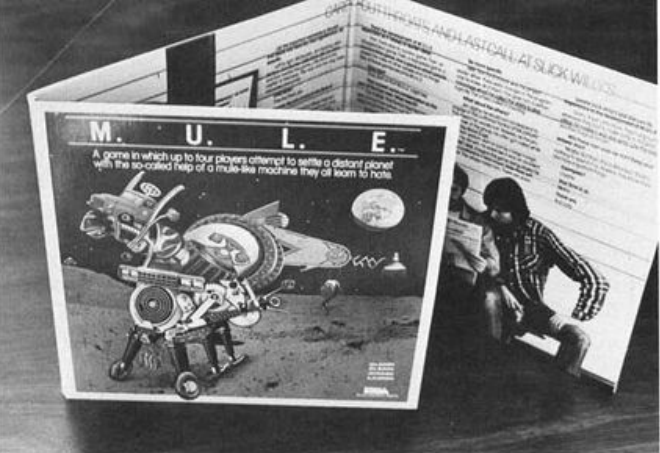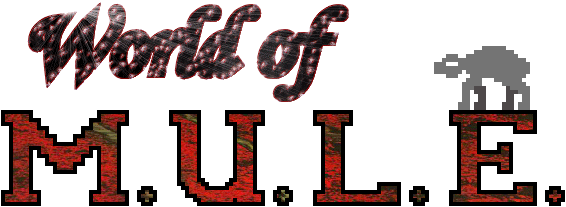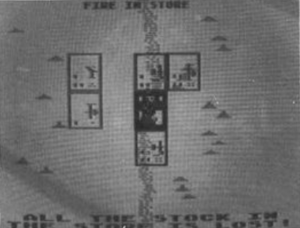Source:
- Archive.org: Computer Gaming World Issue 3.4, July-August 1983
- Direct download from WoM:
 M.U.L.E. Review Computer Gaming World Issue 3.4 July-August 1983 (2.0 MiB, 717 hits)
M.U.L.E. Review Computer Gaming World Issue 3.4 July-August 1983 (2.0 MiB, 717 hits)
M.U.L.E. – Edward Curtis

SYSTEM: Atari 800
FORMAT: Disk
PLAYERS: 1 to 4
PRICE: $40
DESIGNER: Ozark Softscape
PUBLISHER: Electronic Arts, San Mateo, CA
Some time in the future, on a planet far far away, four beings are left to
develop the planet with only the so-called help of temperamental M.U.L.E.s
(Multiple Use Labor Elements). An interactive game for four players (the
computer being able to play up to three of them), M.U.L.E. is a thoughtfully
designed and quick playing game which contains the finer aspects of an oil
exploration game, an auction game, a real estate game and bits of others which, as stated on the inside of the jacket, “…died so that M.U.L.E, might live.” A design of Ozark Softscape (Dan Bunten, Bill Bunten, Jim Rushing, and Alan Watson), this is a game which pits you not only against each other, but the colony as a whole is also judged at the end of game for overall success.
A definite bonus with M.U.L.E. is it’s packaging (as it is also with the other
products recently released) by Electronic Arts. The jacket, beyond the humor that it uses, is well executed in both artistic design and in the information that it contains.
The M.U.L.E. Player’s Guide is another example of a well designed adjunct to the actual program. Each of the three levels of play (Beginner, Standard, and Tournament) are given their own section of the guide which includes the basic rules or additional rules for that level and tips which can help quite a bit. The guide also includes a page of answers to the most common questions asked by the beginning players, the two basic laws of production for the basic commodities used in the game, and the strategies and opinions of the infamous “gang of four”(Dan Bunten, et al.).
As suggested in the Player’s Guide, the novice player should jump directly into playing the Beginner level game after only a cursory reading of the rules. The game itself is its own best tutor. When, after a game or two, a player wants to know just what he has been doing, the guide is still there to be read and now he can hopefully appreciate its explanations.
Each turn is made up of several sections during which different things must be accomplished. The first part of each turn is the “Land Grant” phase. Each player is given the opportunity to select one plot of land from the five by nine grid which makes up the colony. The players choose their land based upon what they want to produce and where their other land is lo- cated (as these factors will effect the plots production).
The player will then, in the development phase, decide which of the commodities is best to develop in regards to the previous turns supply and perhaps his personal shortage. On his part of this phase, the player goes to the town corral (the town is located in the center of the map), buys a M.U.L.E., and outfits it to produce which ever commodity is desired. The player then leads the temperamental creature to his newly aquired plot and sets him up for production by centering himself over the hut which appears in each undeveloped plot of land. This phase is ended either by the player’s time running out or by his getting back to the town and entering the pub (which will gain him an amount of money from gambling based upon the amount of time which he has left).
After the last player has developed any land that he has had time to develop, the established M.ULL.E.s produce the commodity for which they were outfitted. All production completed, the game then goes to the “auction phase”. It is during this phase that any player with an excess in any given commodity has the opportunity to sell his excess to either a player with a shortage, or to the town store. The price received depends upon the supply and the last price paid for the given commodity. The turn ends with a display which shows each player’s relative worth and the value of the colony as a whole.
The Beginner’s level of play introduces the player to the three basic
commodities produced on Irata (the planet on which all of this is taking
place) and the basic economic rules which determine the level of their
production. Each of the commodities (Food, Energy, and Smithore) has a definite use in developing the colony and each player’s land. The players also learn that the production of the commodities varies due to the type of land on which it is being produced. Food, which is needed to give the player a full time allotment with which to develop his plots of land (each player gets one lot per turn), grows best in the river valley which runs down the center of the map. Energy, which is needed for production of the other two commodities, is best produced in the flatlands. And Smithore, which is needed for the continued production of M.U.L.E.s, is produced best in the mountains.
There are two “Laws of Economics” which, as mentioned above, rule the degree of production on a player’s land. The first, Economies of Scale, states that the larger an operation is, the more efficient it is in producing a given commodity. You will, therefore, gain one extra unit of production on each plot of land which is adjacent to another of your lots which is producing the same thing. If, for example, two of your adjacent lots were both producing energy and both had base production of three units per turn, then their actual production, due to the Economies of Scale, would be four units per turn.
The other “Law” is the Learning Curve Theory of Production. This theory states that every time you double the number of units that you have ever produced, your production costs go down 20% due to improvements in production methods. In M.U.L.E. this is translated into your getting one extra unit of production on each plot for every three plots producing a specific commodity, no matter where it is located. Using the last example, if that player were to add one more plot of land anywhere on the map, each plot would have their production increased by one. And, unlike the Economies of Scale which can only increase a plot’s production by one, the Learning Theory of Production will increase your production by one for every three plots producing the same thing.
The Standard Game introduces the players to two new features which can have dramatic effects on the outcome of the game. Land is the key to the changes in the Standard Game. Immediately after the Land Grant phase, there is a chance that the colony authorities will auction off up to six extra plots of land (on the average, only one lot is auctioned). Getting extra lots early in the game can mean a jump on getting production bonuses that will put you into an early lead and, in turn, make you that much better off when other lots are auctioned off. The other change in land rules is in the ability to sell land that is not needed (to get money for other more useful land) or just to get money with which to feed yourself. The buying of land in both the town organized sales and in the player sales are handled in the same auction format as is the trading of commodities in the auction section of the game. The only difference between the two types of land auctions is that the seller has the right to refuse to sell at any time up to the close of the auction if he is not satisfied with any aspect of the sale.
It is during the Tournament Game that the final commodity is introduced into the game. Crystite, the fourth commodity, is distributed without regard to terrain, with the exception that it can not be mined in the river valley. It is also the only commodity whose price is not dependent upon supply and demand, as all of it is shipped off planet and has no local use (the price of crystite randomly varies within set parameters). As the re- lative worth of a plot of land for Crystite production can not be known from land features, a new office is opened in the town: the assay office. Players can check the base production of any plot of land by taking a sample of soil to the assay office for a report (which, of course, uses up some of the players precious time)
The last thing added in the Tournament Game is the powerful ability for players to Collude. During any auction, two players may choose to collude in order to sell to one another while preventing another player from getting a needed commodity. Collusion also works during private land auctions by allowing only a chosen player to bid for the land in question.
While these descriptions of M.U.L.E. have been far from complete, they do
capture the basics of a game which has very few aspects which one might wish to alter. The first point which came to question was the lack of a “save game” option. While even the Tournament Game is only twelve turns long and takes less than two hours, itis still aggravating to have to kill an almost completed game for lack of time. It would also have been an improvement if the robot players could have been a bit brighter. They become rather predictable after a time and it becomes relatively easy to take advantage of them. The greatest complaint that could be found in a game which is so enjoyable is that it is just too short. To increase the length of the game and keep its dynamics of play would, unfortunately, necessitate a major revision and expansion of the game. It is a task which we will just have to wait for with great expectations.
M.U.L.E. is a fascinating and very enjoyable game which comes to its best point with four human players. The interaction and demands on creating a development strategy which can not only change from game to game, but from turn to turn, makes this a game which will continue to be played long after others are put aside to collect dust.

